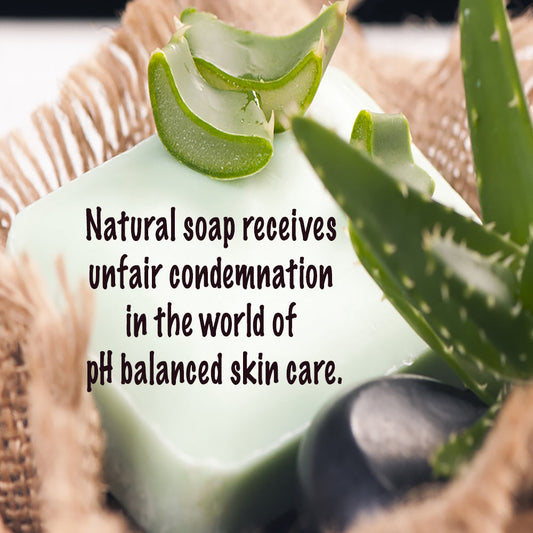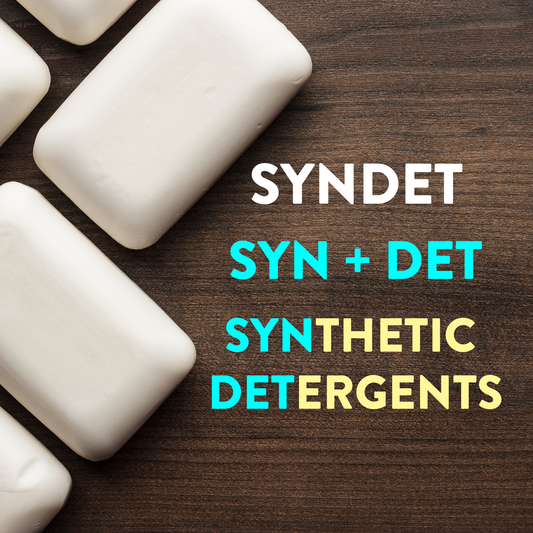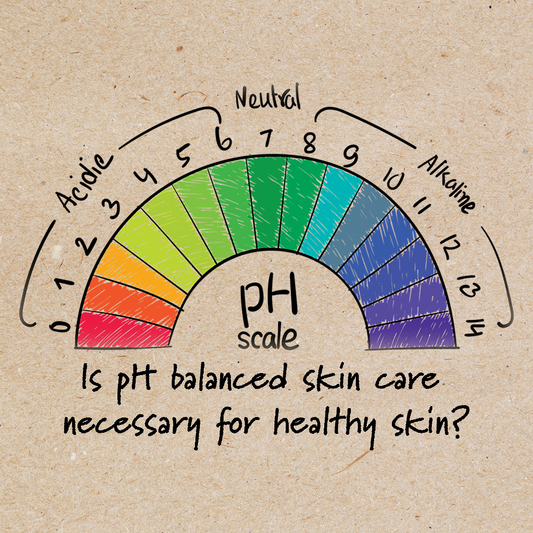Sodium Coco Sulfate: Is It Natural?
If It Comes From Coconuts . . . It Must Be Natural
…a friend gave me a NATURAL pink shampoo puck from a company called “______ Organics.” The first ingredient is “Sodium coco sulfate” which is a synthetic detergent on google and it is pink. My friend believes this ingredient is good because the company says it comes from coconuts...

We often receive emails questioning ingredients, information and/or practices represented by other companies.
There are many companies that create great "natural skincare" marketing campaigns but do NOT create "natural skincare" products.
While I will admit that these companies are often a source of great angst for me, more importantly, they remind me of how lucky I am and how proud I am to be part of a company that truly believes in natural skin care.
Now some will want to dismiss this article saying that I have a bias against using synthetic ingredients in skin and hair care products. I will be the first to admit that is true.
I do recognize that the choice of skin and hair care products is a very personal decision and natural products may not work for everybody and may not solve every problem.
In this blog, I would like to talk about the ingredient mentioned in the email, Sodium Coco Sulfate.
My goal is not to debate whether or not Sodium Coco Sulfate is less irritating, safer, or better than other sulfates. My goal is not to convince you that it is an undesirable ingredient. My goal is to explain what it is and why it is used.
What Is Sodium Coco Sulfate?
The email above is one of many. One customer recently asked . . .
Do you know anything about Sodium Coco Sulfate? I was told that it is a natural mild cleanser made from coconuts, not petroleum like SLS. Is it more like soap?
 Sodium Lauryl Sulfate, Sodium Laureth Sulfate, and Ammonium Lauryl Sulfate are the three most common Sulfates used in personal care products.
Sodium Lauryl Sulfate, Sodium Laureth Sulfate, and Ammonium Lauryl Sulfate are the three most common Sulfates used in personal care products.
Sulfates, including Sodium Lauryl Sulfate (SLS), and all of its cousins, are detergents, a class of chemicals known as surfactants.
Surfactants are needed to achieve a foamy, cleansing lather. They reduce the surface tension of water and bridge the gap between water and greasy dirt, allowing them to bind together and be easily washed away.
Read more about surfactants on our blog "How Does Natural Soap Create Lather?"
Many skincare companies proudly proclaim their cleansing products are "SLS-free." However, if not using a natural surfactant like soap, they are using a synthetic alternative. These alternative ingredients are called synthetic detergents, or syndets. Just because a product is labeled "SLS-free" does not mean it is free from synthetic surfactants or sulfates.
One common substitute for SLS is Sodium Coco Sulfate.
Sodium Coco Sulfate does indeed help create lather. It can be made from coconuts (it can also be made from palm oil). And yes, it is used as a cleansing agent in many products in place of a natural surfactant--like soap.
However, Sodium Coco Sulfate (SCS), like sodium lauryl sulfate (SLS), is another synthetic detergent. This means it is a chemically altered substance created to imitate a natural product that cleans, like soap.
The company referred to in the email hints that Sodium Coco Sulfate is better because Sodium Lauryl Sulfate (SLS) is only made from petroleum. But that is not true because SLS can also be made from palm or coconut oil.
So what's the difference between SLS and SCS? In order to explain we need a wee bit of science.
A Wee Bit of Science About "Fat"

Fats are also known as triglycerides. They are made up of three fatty acids and one molecule of glycerol.
Glycerol, also known as glycerin, is a small organic molecule with 3 carbon atoms and 3 hydroxyl (OH) groups.
A fatty acid consists of a long chain of carbon and hydrogen atoms called a hydrocarbon chain.
A typical fatty acid contains 12–18 carbons, though some may have as few as 4 or as many as 36. Looking at the picture of Lauric acid below, each yellow dot represents a carbon atom most of which are bonded to 2 hydrogen atoms.
It is the fatty acids that are important for this blog.
So, now back to the difference.
What is the Difference Between Sodium Lauryl Sulfate (SLS) and Sodium Coco Sulfate (SCS)?

Coconut-derived Sodium Lauryl Sulfate (SLS) and Sodium Coco Sulfate (SCS) are quite similar.
The difference is rooted in chemistry. The main distinction lies in the type of fatty acid(s) used to synthesize them.
The process of making coconut-derived Sodium Lauryl Sulfate begins with the isolation of one particular fatty acid from the coconut oil called Lauric Acid (C12). Simply put:
- The lauric acid is converted into lauryl alcohol by a process called hydrogenation.
- The lauryl alcohol is then converted into lauryl sulfate by reacting it with sulfuric acid, sulfur trioxide, or chlorosulfonic acid.
- In the final step, the lauryl sulfate is neutralized with or sodium hydroxide. sodium lauryl sulfate
The process to make Sodium Coco Sulfate is the same as described above for SLS except instead of isolating only one fatty acid, SCS is made using all the fatty acids in coconut oil, including lauric acid.
In the chemical reaction, each of the fatty acids in the coconut oil reacts with sulfuric acid to form sulfate esters and is then neutralized with sodium carbonate.
Therefore, since SCS is made from all of the fatty acids in coconut oil, including lauric, it contains SLS.
Notice which fatty acid is present in the greatest amount.

I have noticed many companies using SCS claim that it contains only lauric acid and does not contain any sodium lauryl sulfate (SLS). Unfortunately, they do not understand chemistry.
If all of the fatty acids in the coconut oil chemically react with sulfuric acid, then technically SCS is a "blend" of sodium lauryl sulfate (SLS), sodium myristyl sulfate, sodium palmitate sulfate, sodium stearyl sulfate, sodium caprylic sulfate, etc.
The "coco" part of the name indicates that the fatty acids are derived from coconut oil.
To be clear, SCS is not the same ingredient as SLS, but the bottom line lies in science. SCS contains SLS. Follow this:
- Sodium Coco Sulfate is made using all the fatty acids in coconut oil
- Coconut oil is comprised of around 40 to 50% lauric acid*
- Each of the fatty acids reacts with sulfuric acid to form sulfate esters
- Lauric acid is one of those fatty acids
- Thus, a sulfated ester of Lauric Acid is part of the mix
Lots of personal care manufacturers proudly say they are “SLS-free” since they use Sodium Coco Sulfate (SCS). I believe they are playing the ‘Green Washing Game,' but I will let you be the judge.
The Fatty Acid Composition table comes from an article on ScienceDirect website written by J.J. Lal, et al. in the Encyclopedia of Food Sciences and Nutrition (Second Edition). The percentage of each fatty acid will vary depending on the sample.
*The percentage of Lauric acid will vary depending on the sample.
Why Do Companies Use Sodium Coco Sulfate?
If you want to create a product that cleans and lathers you need a surfactant. If not a natural surfactant, like soap, then a synthetic detergent or syndet. By combining variations of different synthetic detergents, a syndet soap or shampoo is formed. Most commercial soaps are actually syndet bars. Liquid shampoo and shower gels are syndets in liquid form.
Shampoo bars are becoming increasingly popular, especially for consumers concerned about plastic waste. The solid bars can be easily packaged in a recyclable cardboard box.
Some more "natural" companies have traded Sodium Lauryl Sulfate for other synthetic surfactants like Sodium Coco Sulfate or Sodium Cocoyl Isethionate. Their more complex molecular structure is believed to cause less skin and scalp irritation than SLS.
Since many people have been using traditional liquid shampoo their whole lives, switching to a bar form is a big change. The shampoo bars containing Sodium Coco Sulfate are made with many of the same ingredients as your favorite liquid shampoo, only without the extra water and plastic bottle. These syndet bars usually create a lot of foamy lather and come in fun colors and scents.
Hard water can make it more difficult to create a good lather and to rinse all of a natural soap-based shampoo from your hair. Since synthetic detergents or surfactants do not bind with minerals in hard water they rinse more easily than soap which is why synthetic detergents have become the laundry detergent of choice by most people.
It makes sense that if your hair and scalp have adapted to and accepted as normal the ingredients in a bottled detergent shampoo, you may have little or no adjustment period to a detergent-based shampoo bar. That is the argument for using a syndet bar made by the companies that make them.
A Few Words About Ingredients Derived From ...
Words like “natural,” “naturally sourced,” “plant-derived,” and “derived from nature” have become little more than marketing buzzwords. With no legal definitions to back them up, these terms are often used loosely, creating a false impression of a product’s natural integrity and deceiving even the most informed consumers.
 For example, it is common to see ingredients like sodium coco sulfate (SCS), sodium cocoyl isethionate, or sodium methyl cocoyl taurate followed by the words “a gentle cleanser derived from coconuts."
For example, it is common to see ingredients like sodium coco sulfate (SCS), sodium cocoyl isethionate, or sodium methyl cocoyl taurate followed by the words “a gentle cleanser derived from coconuts."
While these words suggest a connection to nature, they simply mean that the ingredient started out at some point as a whole plant. They do not account for how the plant is processed, how it is modified, or what is added before it reaches its final form.
In truth, many so-called “plant-derived” ingredients undergo such a significant transformation that they bear little resemblance to their original plant.
So why do manufacturers use these words? Just look at the emails I cited at the beginning. Since consumers equate these words with "natural," shoppers often believe they are purchasing a healthier product.
We believe in using ingredients that are found in nature, naturally occurring, rich in nutrients, and as close to their original form as possible. Ingredients like cold-pressed oils and butters, organic essential oils, dried herbs, and botanicals.
Final Thoughts About Sodium Coco Sulfate
While I love coconut oil, its science lab derivatives like Sodium Coco Sulfate (and its other cousins like Sodium Cocoyl Isethionate) are synthetic surfactants. They are not natural ingredients and the chemical processes used to create them often strip away most of the beneficial components.
There is a lot of debate about the safety of sulfates--and other synthetic ingredients. Companies that use these ingredients state, and even cite research to show, that these ingredients can be mild and safe.
Companies who choose not to use synthetic surfactants often cite research to show that these ingredients are linked to skin irritation, allergic reactions, and dermatitis.
It is all very confusing and quite frustrating!
As I stated above, I am not here to debate whether or not Sodium Coco Sulfate is less irritating, safer, or better than other sulfates.
I am obviously biased against using synthetic detergents as an ingredient, but my intention is not to persuade you that all synthetic surfactants are evil.
Ultimately the type of soap or shampoo bar you choose is up to you. I highly encourage you to read the list of ingredients before making a decision.
You can and should always do your own research to decide for yourself whether you want to use a particular ingredient in your home, for your family, or on your skin.
I understand that making the switch to natural haircare might not be for everyone, but I simply believe that companies that brand and market themselves as "natural" should not be using synthetic surfactants in their personal care products under the guise that the starting material of the ingredient is of plant origin (like coconuts).
Natural shampoo bars are easy to use. If you are new to soap-based shampoo bars, finding the right bar is important but I believe that using the proper technique you use to wash your hair is the best way to ensure a successful transition from synthetic shampoo to natural shampoo bars.
Learn more about shampooing techniques on our blog, How to Use a Natural Shampoo Bar, and choose from our wide variety of Shampoo Bars.


